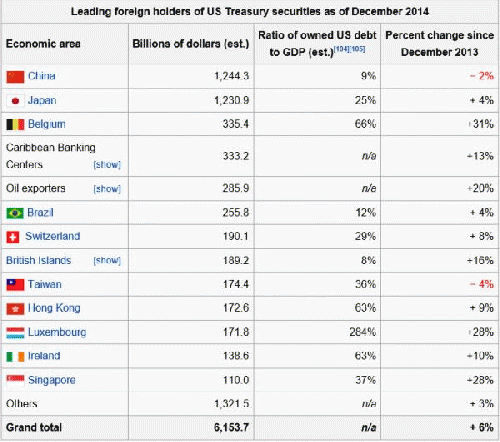I came across this chart from an article at Global Economic Intersection (where I am also a sometimes contributor):

According to statistics from US Treasury Department, China cut US treasury holdings in 2014 by $25.8 billion. Despite all this, China remains US biggest foreign creditor.
(Image by Global Economic Intersection) Details DMCA
A couple of things stand out:
1. China and Japan are by far the largest owners of U.S. Treasury debt. Both benefit from their currency being weakened and ours being strengthened so they can sell us (relatively) cheap goods.
2. WTF is up with Belgium?
Belgium is rapidly increasing its holdings of American debt, up 31% in just a year. Did Belgium suddenly develop a taste for the dollar? No, according to Paul Craig Roberts:
From November 2013 through January 2014 Belgium with a GDP of $480 billion purchased $141.2 billion of US Treasury bonds. Somehow Belgium came up with enough money to allocate during a 3-month period 29 percent of its annual GDP to the purchase of US Treasury bonds.
Certainly Belgium did not have a budget surplus of $141.2 billion. Was Belgium running a trade surplus during a 3-month period equal to 29 percent of Belgium GDP?
No, Belgium's trade and current accounts are in deficit.
Did Belgium's central bank print $141.2 billion worth of euros in order to make the purchase?
No, Belgium is a member of the euro system, and its central bank cannot increase the money supply.
So where did the $141.2 billion come from?
There is only one source. The money came from the US Federal Reserve, and the purchase was laundered through Belgium in order to hide the fact that actual Federal Reserve bond purchases during November 2013 through January 2014 were $112 billion per month.
So, the Fed is propping up purchases of Treasuries to disguise lack of interest from the usual world buyers.
3. Is the same thing happening with Luxembourg? It would certainly seem so. The increase in purchasing is almost as high (28%) and more significantly, tiny Luxembourg now, we are supposed to believe, has 284% of its own GDP invested in U.S. Treasury Bonds. How can that work? How can any country afford that? Why would they even want to try? Especially a country that exports practically nothing to America and so would not gain from a depreciated currency? And anyway, Luxembourg is one of the richest countries in Europe, not a devalued currency country like deflated Greece. Where is this money coming from? Hint: you probably don't have to cross an ocean to find it, just the Potomac River.
The popular Netflix series, House of Cards perpetuated the myth of a finite money supply with this weekend's release of Season 3. In the opening episode, newly ascendent President Underwood presents his plan to create 10 million jobs in an FDR-New Deal type jobs program (good), but proposes to pay for the half trillion dollar program by slashing Social Security, Medicare, Medicaid. The growth of entitlements, he and his staff tell an assembled body of lawmakers and advisers, will bankrupt the country and must be curtailed. I think the current percentage of spending the fictional president cites are 42% presently and 61% by 2020, which is probably pretty close to the deficit hawk values being peddled in real life these days
Social Security does not show up in the Federal Outlay chart because it is independently funded, but the SS Administration says it is the largest part of "total budget expenditures," over 22%:
Presently, the Social Security program is the largest single item in the annual federal government budget. As a percentage of total federal expenditures, in 2002 Social Security benefits were approximately 22.6% of federal expenditures. As a percentage of federal outlays, Social Security benefits have ranged from a low of 0.22% (during World War II) to a high of 23.2% in 2001.
The conventional thinking is that this "expense" - which is really an investment that helps the economy grow almost $2 for every $1 outlayed, because of the money multiplier effect anyway - is paid for from a Trust Fund which in turn is replenished by Treasuries held by that fund, as well as ongoing Payroll deductions. While this is true as far as it goes, it ignores the fact that we have a fiat money system, and the Government could, if it chose to, simply create the money needed in the program without taxing or borrowing anything. And, remember, this program CREATES wealth so it actually saves money to fund it. If we overpay Seniors to the point when they start saving Social Security money and become Asset Investors instead, then it will be a net drain. We are very far from that now. As President Underwood explains, the average Social Security recipient gets just $32k a year. (This is probably close to the mark, but it doesn't matter for this point of discussion). That is not rentier income.
So, if president Underwood really wanted to stimulate the economy, he'd get Congress to issue new debt-free U.S. Notes to fund Social Security AND use that same kind of Sovereign Money to create his 10 million new jobs.
(Note: You can view every article as one long page if you sign up as an Advocate Member, or higher).







